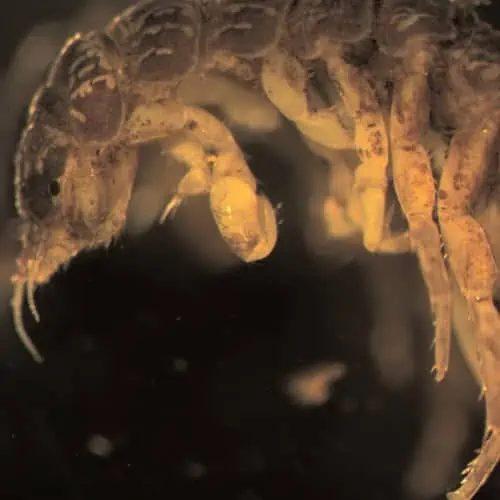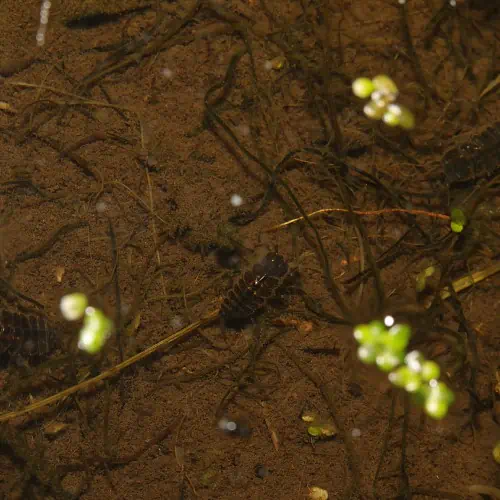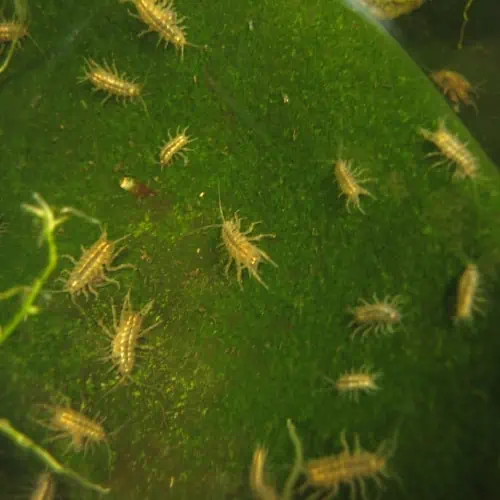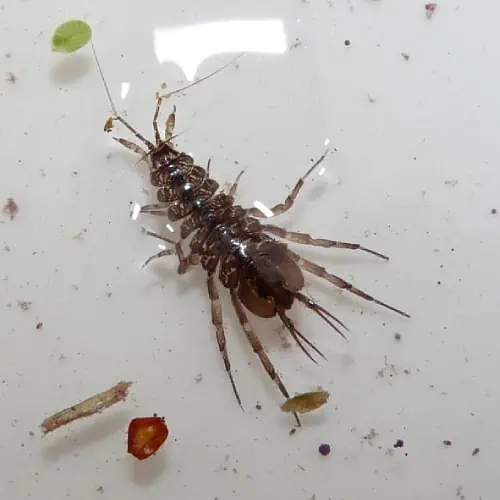
Aquatic sow bugs are fairly omnipresent in all naturally complex bodies of freshwater. These tiny creatures play an important role in these areas as they humbly go about their day-to-day activities. Their foraging behavior can significantly contribute toward maintaining a well-balanced ecosystem. In a sense, they strengthen the links of a functional food web. They play a primary role at the base of the food chain and they serve as decomposers as well.
These beneficial bugs are members of the order Isopoda, a large group of small crustaceans that are distributed all across the globe and throughout all depth levels. Those that are found in freshwater habitats, including caves, usually belong to the Asellidae family. One of the most widespread members is Asellus aquaticus, which goes by the following common names: water louse, pond slater, cress bug, and aquatic sowbug. Note that this isopod is frequently and unfortunately confused with the troublesome Argulus spp., which are parasitic fish lice.
Extant genera under the Asellidae family are found across the northern hemisphere: in Europe, North America, and some parts of Russia. They can persist through temperate conditions with the help of a few adaptations, such as a sturdy exoskeleton, the capacity to breed whenever conditions are optimal (regardless of season), and morphological characteristics which allow them to hide beneath and consume organic matter. Some common species are now being utilized by the aquarium and flyfishing industries as well.
What Do Aquatic Sow Bugs Look Like?

Asellids possess the distinct morphology of freshwater isopods. Their most eye-catching feature is a light to dappled brown, segmented exoskeleton made of chitin and calcium carbonate. Their bodies appear flattened, allowing them to sit flush with the surface of rocks or bottom substrates. The bodies of common genera are divided into three major regions: head, thorax (pereon), and abdomen. The thorax is typically split into 7 horizontal segments, whereas the head and abdomen are not divided.
Each of the major regions is associated with appendages, the features of which are used to distinguish between species. Generally, the head region has 2 pairs (one short and one long) of anteriorly-oriented antennae. On the ventral portion of the head is a bilobed mouth which is adjacent to several feeding appendages. The head is also equipped with a pair of tiny eyes.
The thorax, or the segmented region, has 7 pairs of legs – one pair per segment. Each of the legs is further segmented into 6 regions. Breeding females can be distinguished from non-breeding ones by the presence of flaps that occur close to the base of the anterior legs. Together, these form a brood pouch. Males have a pair of tube-like appendages that arise from the last segment of the thorax. The abdomen is also equipped with segmented appendages, some of which are vital for respiration.
The entire body terminates in a pair of uropods. These are posteriorly projected from the abdomen. The morphology of aquatic sow bugs can seem complex, but the major features to keep an eye out for are a flattened body and the segmented thorax. As these crustaceans are quite tiny, you may need a magnifying glass or a stereoscope to correctly identify them.
Aquatic Sow Bugs Habitat – Where Do They Live?

Asellidae crustaceans are usually bottom-dwelling in natural freshwater habitats, including lakes, ponds, streams, and springs. They favor shallow areas, where decaying plant matter tends to settle, and where aquatic vegetation is present. In these zones, they can be found on the surfaces of substrates, oftentimes underneath rocks and stones. They can also be found crawling inside crevices or maneuvering through webs of entangled roots.
The connectivity of freshwater habitats has shaped the distribution of these aquatic macroinvertebrates. Interestingly, they are now associated with recovering areas, where pollutants once disrupted the balance of freshwater life. The most common species, A. aquaticus, is known for being fairly tolerant of organic pollution, but it may be averse to low pH conditions.
As they are native to temperate zones, they can withstand seasonal fluctuations of temperature. This influences their growth rate, with maturation times speeding up whenever temperatures rise. Populations that are found in cooler, high-altitude regions tend to have a longer maturation period. Some species, particularly those classified under Caecidotea, are found in caves. These understandably have a more cryptic existence, with many that are considered to be possibly extinct.
What Do Aquatic Sow Bugs Eat?

Aquatic sow bugs are able to colonize a wide variety of environments due to their capacity to assimilate many types of food. They are quite efficient as decomposers in areas that accumulate large amounts of detritus. In studies of A. aquaticus, the isopod was observed to scrape the microbial matter on leaf surfaces. Fungi, which is a major component of the biofilm that develops on decaying leaves, can influence food consumption. A. aquaticus has been shown to preferentially feed on conditioned instead of undecomposed leaves.
Apart from being detritivores, Asellidae can be opportunistic omnivores in the sense that they’ll feed on decaying animal matter. Essentially, they are able to consume most types of decaying organic matter, including the microbes that develop on them, due to their diverse gut microbiome.
The Life Cycle of Aquatic Sow Bugs

Although Asellidae species are commonly referred to as ‘bugs’, they have a life cycle that is markedly different from those of insects. Instead of hatching as larvae that have to metamorphose into their adult forms, these crustaceans are born as tiny versions of their older selves. They first develop as fertilized eggs in a ventrally-located brood pouch in mature females. The embryos grow into juveniles inside this pouch. Once they reach a length of about 1 mm, they are released into the wild.
At this extremely tiny size, they may already be morphologically distinguishable as isopods. They then undergo ecdysis, which is the process by which most crustaceans increase in size. This means that as the internal tissues grow, the exoskeleton is consequently shed and eventually replaced by a new one. If environmental conditions are optimal, sexual maturity in A. aquaticus can be reached in as little as 1.5- 3 months. They tend to be around 3 – 4 mm long at this stage.
Interestingly, growth and ecdysis are continuous, even after the sow bug has sexually matured. Reproduction of Asellidae is presumed to require sexual contact, with fertilization taking place only when the oviducal openings of females are freed. This only occurs during a brief period during ecdysis. As a result, males resort to guarding and carrying the females until copulation is possible. Fertilization occurs in the brood pouch, where the female deposits a number of eggs that are relative to her size.
How to Attract Aquatic Sow Bugs to Ponds
As aquatic sow bugs don’t have a terrestrial phase allowing them to traverse across separate water masses, attracting them by natural means isn’t the most plausible concept. If they seem to naturally occur in your wildlife pond, it’s possible that they were dispersed to your area by wild animals (with drenched fur or feathers, for example) or because some pond contents (e.g. substrates, stones, plants) were collected from aquatic sources elsewhere. It is not advisable to transfer materials from one pond to another, however, to avoid contamination.
A safer way to obtain your own aquatic sow bug colonies would be to purchase them from reputable online distributors or aquarium shops. Many isopods, including A. aquaticus, are now quite trendy to have in aquariums as they can serve as food for larger fish. Moreover, their foraging habit can help keep a tank clean.
Are Aquatic Sow Bugs Beneficial?
Many isopods are considered keystone species in areas where they are dominant macroinvertebrates; asellids are no exception. They serve as vital decomposers that can help speed up the nutrient cycling process, diminishing the accumulation of waste and aiding in the maintenance of optimal water parameters. As bioindicators, their presence in areas with organic pollution signals a potential for recovery.
Asellidae have served an important role in research as well, helping scientists explore ecological interactions in freshwater environments. A. aquaticus makes frequent appearances in published works on detritivory. In ponds, bottom-feeders can significantly benefit from the presence of aquatic sow bugs. In general, isopods can make up a huge percentage of the diet of both vertebrate and invertebrate predators. Fluctuations in their distribution can cause significant shifts in the food chain.
Lastly, the importance of isopods as decomposers cannot be stressed enough. Though these creatures tend to be extremely small, their collective foraging efforts can make an enormous difference. Without them, many aquatic systems may struggle to maintain the basic requirements of a healthy freshwater ecosystem.

